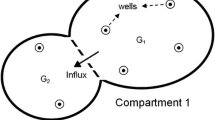Abstract
This paper describes some applications of Mathematical Programming methods to the problem of planning the long term exploitation of oil and gas resources.
Several previously reported oil and gas planning models are reviewed and a newly developed model is described. The earlier models are characterised by the use of implicit representations of reservoir behaviour, using suitable variables and constraints within the problem matrix. This approach gives the greatest freedom to find the most effective planning solution and probably requires the least data, but is often limited in application by the degree of realism that can be achieved in representing reservoir behaviour within available computational resources.
The new model was developed to overcome these limitations. It is formulated as a Mixed Integer Programming model using Special Ordered Sets to identify alternative reservoir production profiles. This permits the description of reservoir production to be as good (or as bad!) as the available data, but limits the variation of investment and production between fields to the range of explicitly defined production profile choices. Possible extensions to the model to allow development profiles to be varied within the model, so reducing the number of explicitly defined profiles needed, are discussed and illustrated.
Similar content being viewed by others
References
H.M. Ali, J.F. Beasley, A.S.J. Batchelor and E.M.L. Beale, “Mathematical models to help manage the oil resources of Kuwait,” SPE paper no 6711, presented at the 52nd Annual Fall Meeting of the Society of Petroleum Engineers of AIME, October 1977.
A.S.J. Batchelor and E.M.L. Beale, “A revised method of conjugate gradient approximation programming,” Presented at the Ninth International Symposium on Mathematical Programming, Budapest, August 1976.
E.M.L. Beale (1974), “A conjugate gradient method of approximation programming,” in: R.W. Cottle and J. Krarup, eds.,Optimisation Methods for Resource Allocation (English University Press, London) p. 261.
E.L. Dougherty, D. Dare, P. Hutchinson, and E. Lombardino, “Optimising SANTO's gas production and processing operations in Central Australia using the decomposition method,”Interfaces 17 (January–February 1987).
E.L. Dougherty and D.H. Thurnau, “A computerised system for planning major investment decisions in oil,” SPE paper no 2586, presented at the 44th Annual Fall Meeting of the Society of Petroleum Engineers of AIME, September 1969.
International Petroleum Engineering Consultants Limited (1987), Client report (April 1987).
G. Rowan and J.E. Warren (1967), “A systems approach to reservoir engineering: Optimum development planning,”Journal of Canadian Petroleum Technology (July 1967) 84.
M.A. Saif, R. Kumar and M. Shanyoor (1987), “Mixed integer, linear programming model for multireservoir strategic planning,” SPE paper No. 15759, presented at the 5th SPE Middle East Oil Show, March 1987.
J. Sullivan (1982), “A computer model for planning the development of an offshore gas field,”Journal of Petroleum Technology (July 1982) 1555.
Author information
Authors and Affiliations
Rights and permissions
About this article
Cite this article
Sullivan, J. The application of Mathematical Programming methods to oil and gas field development planning. Mathematical Programming 42, 189–200 (1988). https://doi.org/10.1007/BF01589403
Received:
Issue Date:
DOI: https://doi.org/10.1007/BF01589403




